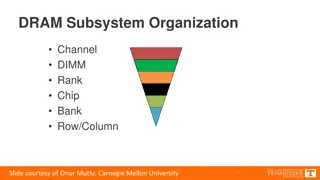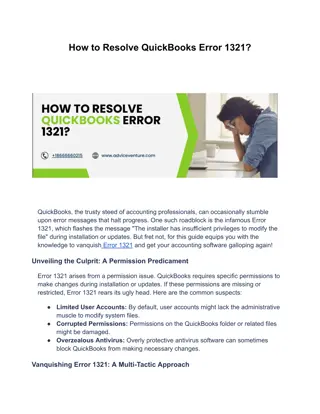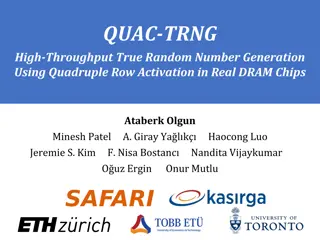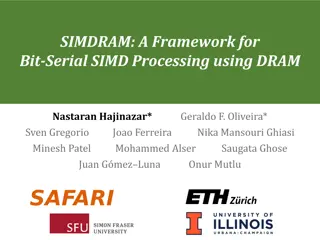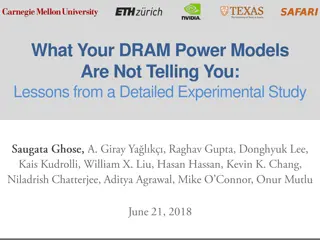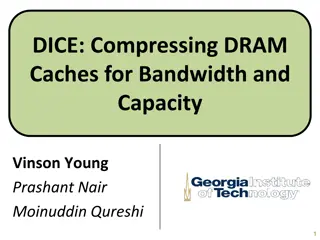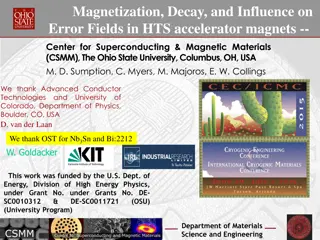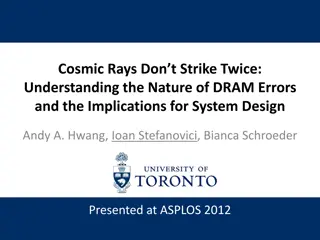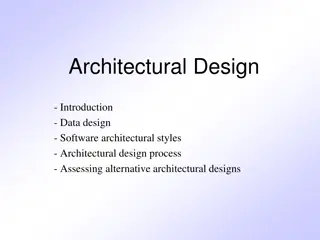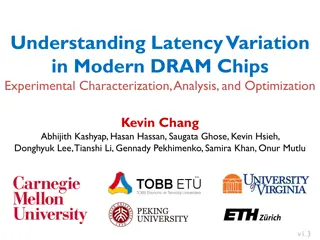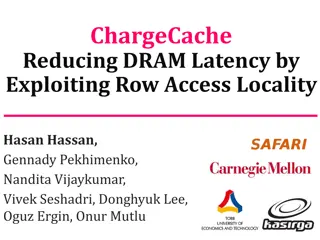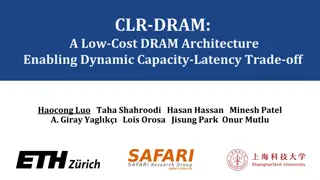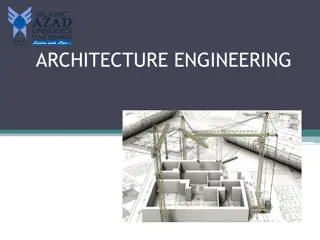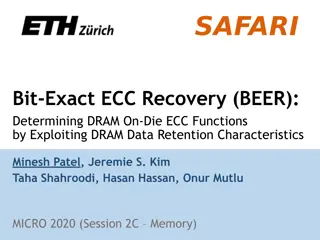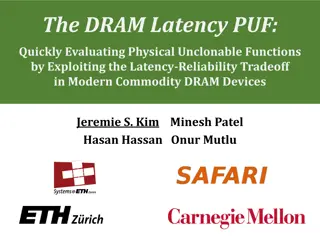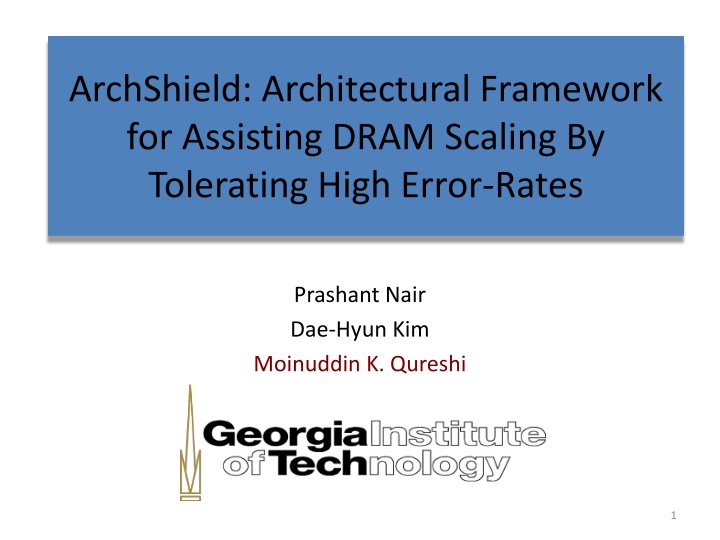
Architectural Framework for Assisting DRAM Scaling by Tolerating High Error Rates
DRAM scaling faces challenges due to shrinking cells leading to errors. ArchShield offers a framework to mitigate errors and facilitate technology scaling. Explore the difficulties in DRAM scaling, reasons for faults, and innovative solutions like row and column sparing schemes. Learn about the constant volume of capacitance, aspect ratio trends, and more.
Download Presentation

Please find below an Image/Link to download the presentation.
The content on the website is provided AS IS for your information and personal use only. It may not be sold, licensed, or shared on other websites without obtaining consent from the author. If you encounter any issues during the download, it is possible that the publisher has removed the file from their server.
You are allowed to download the files provided on this website for personal or commercial use, subject to the condition that they are used lawfully. All files are the property of their respective owners.
The content on the website is provided AS IS for your information and personal use only. It may not be sold, licensed, or shared on other websites without obtaining consent from the author.
E N D
Presentation Transcript
ArchShield: Architectural Framework for Assisting DRAM Scaling By Tolerating High Error-Rates Prashant Nair Dae-Hyun Kim Moinuddin K. Qureshi 1
Introduction DRAM: Basic building block for main memory for four decades DRAM scaling provides higher memory capacity. Moving to smaller node provides ~2x capacity Shrinking DRAM cells becoming difficult threat to scaling Scaling (Feasibility) Efficient Error Mitigation Technology node (smaller ) Efficient error handling can help DRAM technology scale 2
Why DRAM Scaling is Difficult? Scaling is difficult. More so for DRAM cells. Volume of capacitance must remain constant (25fF) Scaling: 0.7x dimension, 0.5x area 2x height With scaling, DRAM cells not only become narrower but longer 3
DRAM: Aspect Ratio Trend Narrow cylindrical cells are mechanically unstable breaks 4
More Reasons for DRAM Faults Unreliability of ultra-thin dielectric material In addition, DRAM cell failures also from: Permanently leaky cells Mechanically unstable cells Broken links in the DRAM array DRAM Cells Q DRAM Cell Capacitor (tilting towards ground) Charge Leaks DRAM Cell Capacitor Permanently Leaky Cell Mechanically Unstable Cell Broken Links Permanent faults for future DRAMs expected to be much higher (we target an error rate as high as 100ppm) 5
Outline Introduction Current Schemes ArchShield Evaluation Summary 6
Row and Column Sparing DRAM chip (organized into rows and columns) have spares Replaced Columns Deactivated Rows and Columns Spare Columns Faults Replaced Rows Spare Rows DRAM Chip: DRAM Chip: After Row/Column Sparing Before Row/Column Sparing Laser fuses enable spare rows/columns Entire row/column needs to be sacrificed for a few faulty cells Row and Column Sparing Schemes have large area overheads 7
Commodity ECC-DIMM Commodity ECC DIMM with SECDED at 8 bytes (72,64) Mainly used for soft-error protection For hard errors, high chance of two errors in same word (birthday paradox) For 8GB DIMM 1 billion words Expected errors till double-error word = 1.25*Sqrt(N) = 40K errors 0.5 ppm SECDED not enough for high error-rate (+ lost soft-error protection) 8
Strong ECC Codes Strong ECC (BCH) codes are robust, but complex and costly Strong ECC Encoder + Decoder Memory Controller DRAM Memory System Memory Requests Memory Requests Each memory reference incurs encoding/decoding latency For BER of 100 ppm, we need ECC-4 50% storage overhead Strong ECC codes provide an inefficient solution for tolerating errors 9
Dissecting Fault Probabilities At Bit Error Rate of 10-4 (100ppm) for an 8GB DIMM (1 billion words) Faulty Bits per word (8B) Probability Num words in 8GB 0 99.3% 0.99 Billion 1 0.007 7.7 Million 26 x 10-6 2 28 K 62 x 10-9 3 67 10-10 4 0.1 Most faulty words have 1-bit error The skew in fault probability can be leveraged to develop low cost error resilience Goal: Tolerate high error rates with commodity ECC DIMM while retaining soft-error resilience 10
Outline Introduction Current Schemes ArchShield Evaluation Summary 11
ArchShield: Overview Inspired from Solid State Drives (SSD) to tolerate high bit-error rate Expose faulty cell information to Architecture layer via runtime testing Replication Area Fault Map Main Memory ArchShield Most words will be error-free 1-bit error handled with SECDED Fault Map (cached) Multi-bit error handled with replication ArchShield stores the error mitigation information in memory 12
ArchShield: Runtime Testing When DIMM is configured, runtime testing is performed. Each 8B word gets classified into one of three types: No Error 1-bit Error Multi-bit Error (Replication not needed) SECDED can correct hard error Word gets decommissioned SECDED can correct soft error Need replication for soft error Only the replica is used (Information about faulty cells can be stored in hard drive for future use) Runtime testing identifies the faulty cells to decide correction 13
Architecting the Fault Map Fault Map (FM) stores information about faulty cells Per word FM is expensive (for 8B, 2-bits or 4-bits with redundancy) Keep FM entry per line (4-bit per 64B) Faulty Words FM access method Table lookup with Lineaddr Main Memory Fault Map Avoid dual memory access via Caching FM entries in on-chip LLC Each 64-byte line has 128 FM entries Exploits spatial locality Replicated Words Replication Area Fault Map Organized at Line Granularity and is also cachable Line-Level Fault Map + Caching provides low storage and low latency 14
Architecting Replication Area Faulty cells replicated at word-granularity in Replication Area Fully associative Replication Area? Prohibitive latency Set associative Replication Area? Set overflow problem Set 1 Set 1 Faulty Words Main Memory Set 2 Set 2 Fault Map Replicated Words Replication Area Fully Associative Structure Set Associative Structure Chances of Set Overflowing! 15
Overflow of Set-Associative RA There are 10s/100s of thousand of sets Any set could overflow How many entries used before one set overflows? Buckets-and-Balls 6-way table only 8% full when one set overflows Need 12x entries
Scalable Structure for RA Replication Area Entry OFB 1 PTR 16-Sets OFB 1 PTR TAKEN BY SOME OTHER SET 16-overflow sets With Overflow Sets, Replication Area can handle non uniformity
ArchShield: Operation Check R-Bit 1. R-Bit Set, write to 2 locations OS-usable Mem(7.7GB) Read Transaction Last Level Cache Miss! 2. Else 1 location Write Request R-bit R-bit Fault Map Line Fetch Fault Map (64 MB) Read Request Last Level Cache 1. Query Fault Map Entry 1. Query Fault Map Entry 1. Query Fault Map Entry 2. Fault Map Miss 2. Fault Map Hit: No Faulty words 2. Fault Map Hit: Faulty word Replication Area (256MB) Read Transaction Replication Area Set R-Bit Faulty Words Fault Map Entry Main Memory Replicated Word 18
Outline Introduction Current Schemes ArchShield Evaluation Summary 19
Experimental Evaluation Configuration: 8-core CMP with 8MB LLC (shared) 8GB DIMM, two channels DDR3-1600 Workloads: SPEC CPU 2006 suite in rate mode Assumptions: Bit error rate of 100ppm (random faults) Performance Metric: Execution time norm to fault free baseline 20
Execution Time Two sources of slowdown: Fault Map access and Replication Area access 1.08 ArchShield (No FM Traffic) Normalized Execution Time 1.06 ArchShield (No Replication Area) 1.04 ArchShield 1.02 1.00 0.98 0.96 Low MPKI High MPKI On average, ArchShield causes 1% slowdown 21
Fault Map Hit-Rate 1.0 0.9 0.8 0.7 Hit-Rate 0.6 0.5 0.4 0.3 0.2 0.1 0.0 High MPKI Low MPKI Hit rate of Fault Map in LLC is high, on average 95% 22
Analysis of Memory Operations Transaction 1 Access(%) 2 Access (%) 3 Access (%) Reads 72.1 0.02 ~0 Writes 22.1 1.2 0.05 Fault Map 4.5 N/A N/A Overall 98.75 1.2 0.05 1. Only 1.2% of the total accesses use the Replication Area 2. Fault Map Traffic accounts for <5 % of all traffic 23
Comparison With Other Schemes ArchShield FREE-p ECC-4 1.30 Normalized Execultion Time 1.25 1.20 1.15 1.10 1.05 FREE-p 1.00 ECC-4 0.95 ArchShield 0.90 High MPKI Low MPKI 1. The read-before-write of Free-p + strong ECC high latency 2. ECC-4 incurs decoding delay 3. The impact of execution time is minimum in ArchShield 24
Outline Introduction Current Schemes ArchShield Evaluation Summary 25
Summary DRAM scaling challenge: High fault rate, current schemes limited We propose to expose DRAM errors to Architecture ArchShield ArchShiled uses efficient Fault Map and Selective Word Replication ArchShield handles a Bit Error Rate of 100ppm with less than 4% storage overhead and 1% slowdown ArchShield can be used to reduce DRAM refresh by 16x (to 1 second) 26
Questions 27
Monte Carlo Simulation Probability that a structure is unable to handle given number of errors (in million). We recommend the structure with 16 overflow sets to tolerate 7.74 million errors in DIMM. 28
ArchShield FlowChart Entries in bold are frequently accessed 29
Memory Footprint 31

